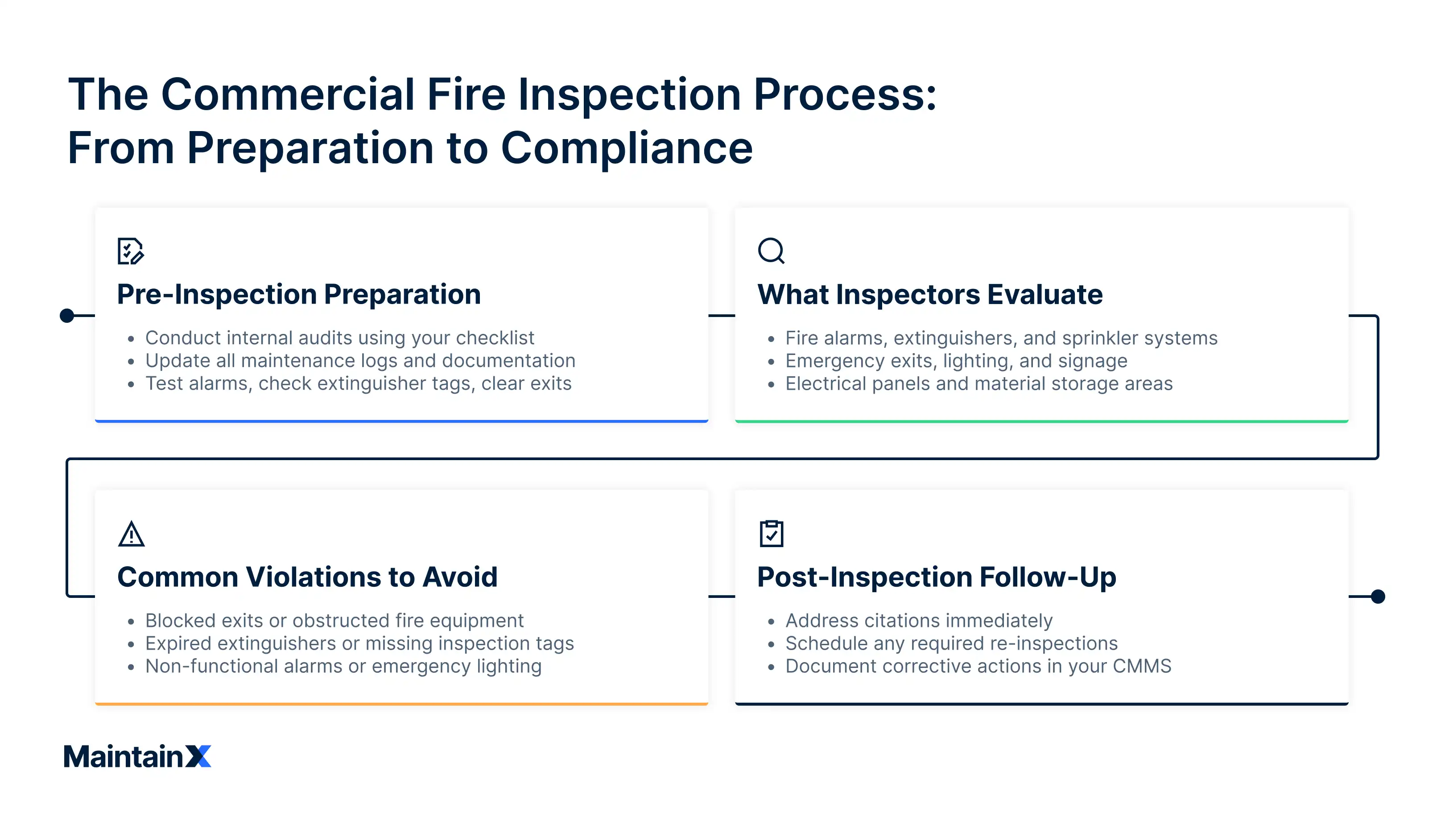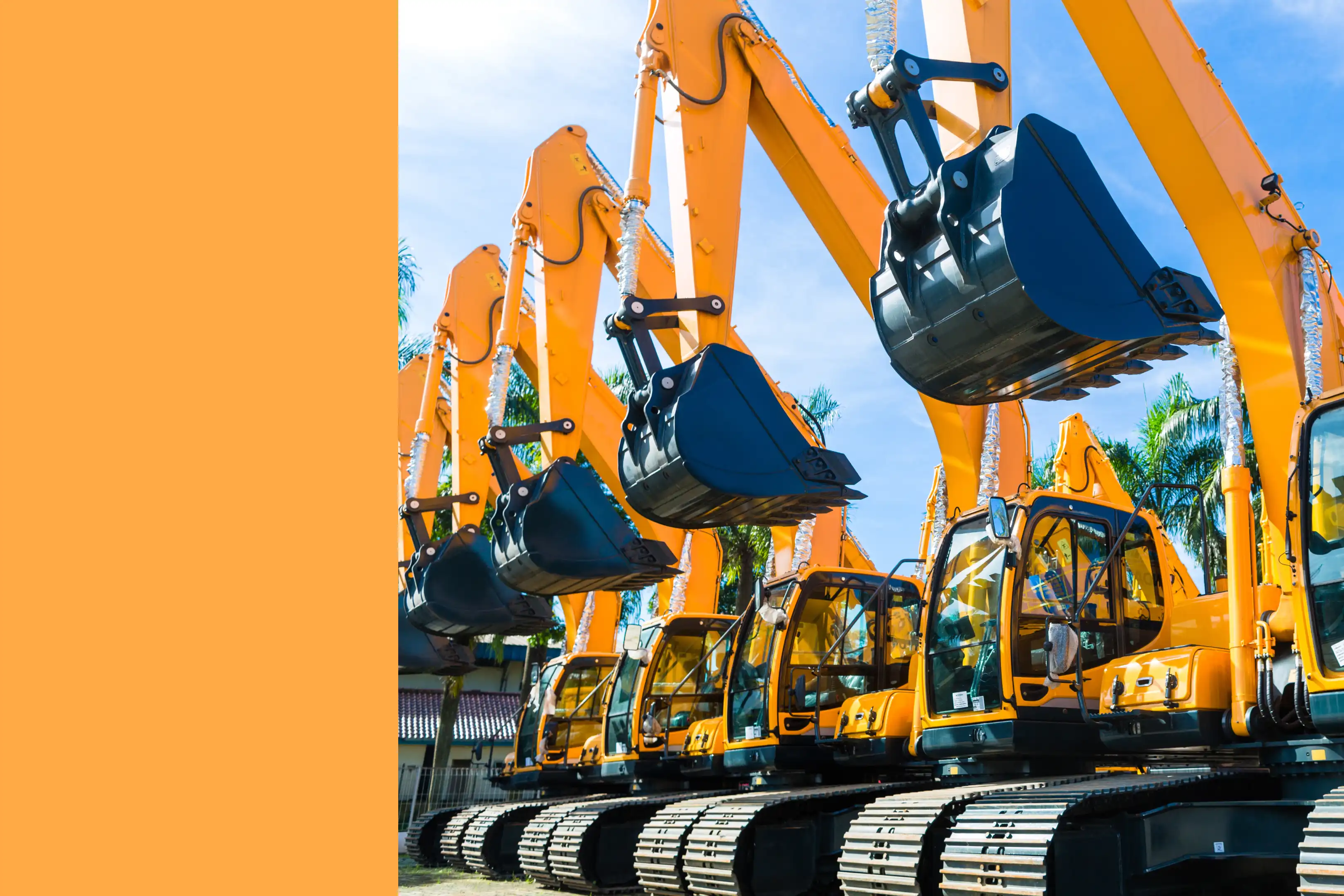
Commercial facilities have complex fire safety requirements; a commercial fire inspection checklist is an effective way to streamline inspection prep and internal audits.
In this guide, we share a ready-to-use checklist template that you can tweak for your property. We’ll cover some of the fire safety standards applicable to U.S. companies, so you’re better prepared for an inspection. We’ll also offer some insights into what inspectors typically look for.
Key takeaways
- A commercial fire inspection checklist helps verify that fire protection systems work correctly.
- You must follow OSHA requirements, NFPA standards, and local fire codes to stay legally compliant and maintain insurance coverage.
- Accurate records are necessary to prove compliance and help avoid penalties.
- A CMMS helps you automate maintenance scheduling, store records, and track maintenance checklists in real time.
How to use this checklist
Here’s a quick overview of how you can use the commercial fire inspection checklist provided in this guide.
Customize your checklist
Your fire equipment portfolio, facility layout, workforce size, and business processes are unique to your company. Our general-purpose fire safety checklist will get you started, but you’ll need to tweak it to your needs.
Implement and monitor tasks
Determine the ideal frequency for each task in your checklist, add instructions according to your standard operating procedures (SOPs), and check in to make sure your technicians are completing their assigned tasks.
Use a CMMS
Use a computerized maintenance management system (CMMS) to track and monitor the progress of your checklist. A CMMS lets you automate assigning and tracking tasks in an interface that’s easy for everyone—from managers to technicians—to work with.
If you’re still using spreadsheets, it’s time to migrate to a CMMS. The automated audit trail, built-in collaboration, and insightful reports make a CMMS the best option for maintenance management and regulatory compliance.
What do inspectors check during a commercial fire inspection?
To create a comprehensive checklist, you need to know what inspectors look at during a commercial fire inspection. Here’s an overview of what these inspections typically cover.
Fire alarm systems
Fire extinguishers and hydrants
Emergency exits and lighting
Sprinkler systems
Electrical hazards
Fire pumps and connections
Storage and housekeeping
Signage and documentation
Building access and fire separation
Facility systems
Special hazards

Regulatory compliance and standards
Regulatory compliance requirements depend on your location and the nature of your property. Here are some common requirements applicable to commercial properties.
- Occupational Safety and Health Administration (OSHA): According to OSHA, employers are required to provide safe exit routes, maintain functional fire protection systems, train staff in emergency protection systems, and minimize fire hazards through effective maintenance.
- National Fire Protection Association (NFPA): NFPA has an extensive framework that spells out specific fire safety requirements for commercial facilities. For example, NFPA 101 addresses life safety, while NFPA 10 and NFPA 25 focus on fire extinguishers and sprinkler systems.
- Local fire codes: Your local fire code adds another layer of requirements for fire safety. Local rules typically reflect both regional risks and general best practices.
You may also need to comply with other standards based on your industry or insurance provider. These standards help you minimize liability risk and prevent problems with insurance claims in the event of an incident.
Tips for passing a commercial fire inspection
Commercial fire inspections are typically triggered by complaints or insurance requirements; in some circumstances, facilities may be required to undergo regular inspections annually or more frequently.
If you’re about to face a fire inspection, here are a few tips to help you prepare.
- Schedule routine internal checks: Run an inspection yourself using this checklist to proactively find potential issues. Conduct a monthly walkthrough to test alarms, confirm extinguisher pressure, clear exit routes, check fire doors, and verify other fire safety measures.
- Keep maintenance logs up to date: Inspectors will likely request proof to verify that you service equipment regularly. Use a CMMS to organize records for fire safety equipment so it’s easily accessible at the time of inspection.
- Train your staff: Ensure that everyone in the building is familiar with evacuation routes and knows where to locate fire safety equipment. Conduct regular drills (and document them as evidence) to show inspectors that your team can respond effectively during an emergency.
- Fix minor issues immediately: Even minor issues like a missing tag or blocked exit can make the inspector skeptical about overall safety practices at your property. Pay attention to details and fix minor problems as soon as they arise.
- Work with certified professionals: Your fire protection systems need testing and maintenance by qualified professionals. Use certified contractors where necessary to avoid noncompliance citations.
- Stay informed about code updates: Regulations are constantly changing, so subscribe to your local fire department’s notices or NFPA updates to stay current with new requirements.
- Build a relationship with your fire department: A cooperative approach goes a long way. You can also ask questions and request pre-inspection visits to show that your organization takes fire safety seriously.
- Document everything: Store copies of inspection reports, permits, certifications, and other relevant documents in your CMMS. An organized, centralized document repository speeds up inspection and builds credibility with inspectors.
Documentation and record-keeping best practices
Inspectors rely heavily on documentation during inspections to verify that your safety systems are properly maintained. But just having documentation isn’t enough—your documents should be well-organized and instantly accessible.
Here are a few best practices to ensure your fire safety documentation is always ready for an inspection:
- Use a CMMS: A CMMS automatically documents every maintenance activity and inspection, storing all records in the cloud for easy, centralized access.
- Control access and updates: Limit editing rights to authorized personnel and keep version histories. Many top CMMS platforms, like MaintainX, offer role-based access, making it easier to manage access. Limited access minimizes the risk of accidental deletion and maintains the integrity of records that fire marshals or insurance auditors might review.
- Retain records for the required period: Federal, state, and local standards typically mandate a retention period for critical records. Some facilities may require documentation to be available for several years, especially those with high-risk operations. Make sure you retain records in your CMMS as required by applicable laws and standards.
- Back up everything: Your data is safe with a reliable CMMS platform, but it’s good practice to maintain a backup.
Digitize your commercial fire inspection checklists
The best way to manage your fire inspection checklist is to digitize it using a CMMS. With a mobile-friendly CMMS, your technicians can mark tasks complete using their phones, or ask questions in real time. At the same time, you can track maintenance progress, access an automated audit trail, and view auto-generated reports.
Beyond helping you pass a fire inspection, a CMMS streamlines a broad range of facility management workflows. To learn more, book a demo to see MaintainX in action.
FAQs
What is the purpose of a commercial fire inspection?
A commercial fire inspection evaluates your building’s fire protection systems, like alarms and sprinklers, to see if you meet fire safety regulations. During the inspection, the inspector identifies fire hazards, checks your overall emergency preparedness, and confirms that people can evacuate safely in an emergency.
How often should a commercial property undergo a fire inspection?
How often should a commercial property undergo a fire inspection?
Most commercial properties are inspected annually, but frequency may vary by location and occupancy type. For example, high-risk facilities like restaurants or industrial plants require more frequent inspections—say, semiannual or quarterly. Check your local fire code and insurance requirements to be sure.
What are the most common fire safety violations?
Common fire code violations include blocked exits, missing or expired fire extinguishers, non-functional alarms, faulty emergency lighting, and poor housekeeping that creates fire hazards. Incomplete maintenance records are also a common issue.
How can I prepare my building to pass a fire inspection?
Here are a few suggestions:
- Test fire sprinkler systems (or fire inspection systems) and alarms before the inspection
- Check extinguisher tags
- Clear exit routes
- Make sure the emergency lights work
- Keep maintenance logs and inspection reports organized and accessible
- Address small issues immediately to avoid citations
What documentation do inspectors typically review during a commercial fire inspection?
Inspectors review fire alarm test reports, sprinkler maintenance logs, extinguisher inspection tags, staff training records, evacuation plans, and previous inspection reports. They also verify that your permits and certifications are up to date.
What regulations and standards should my property comply with for fire safety?
As a U.S.-based company, you must comply with OSHA workplace safety standards, NFPA codes, and local fire department regulations. There may also be additional safety requirements imposed by your industry or insurance company.






